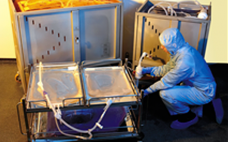Cell culture processes are a vital part of manufacturing, yet the bioprocessing industry still needs optimized process development approaches. Increasing interest in chemically defined media, perfusion cell processes, and high-throughput approaches are driving the need for better understanding of cell culture characterization and process development for current and next-generation protein therapeutics. Process Development Optimizing the business process of cell line development involves creating competitive advantages with increased efficiency and reduced risk. âIntelligent business practices that…
Saturday, September 1, 2012 Daily Archives
QbD for Biologics: Learning from the Product Development and Realization (A-MAb) Case Study and the FDA OBP Pilot Program
Cosponsored by CASSS (an international separation society) and the FDA, the 23rd CMC Strategy Forum was held in Bethesda, MD, on 19â20 July 2010. For the third time, this forum explored the topic of quality by design (QbD) for biologics. The first such forum was held in July 2007 and focused on establishing a general understanding of QbD terminology and concepts. In July 2008, the second discussed approaches for submission of QbD data and associated regulatory implications. Building…
Recovery and Purification
Modern separation and purification engineers are hard tasked with handling concentrated feed streams, recalcitrant proteins, and new contaminant profiles coming from the use of serum-free culture media. With regulatory, public, and industry attention increasingly focused on the subject of viral safety, for example, a risk-based approach following an FDA quality systems initiative continues to build momentum. That regulatory perspective affects how recovery and purification unit operations are designed and conducted. Process modeling software is becoming increasingly sophisticated, so…
Legacies in Bioprocessing
Bioprocessing is full of legacies. Our remote ancestors discovered fermentation: microbial magic that transformed fruit to wine and grain to beer. Building on the work of Edward Jenner and others, Edward Ballard systematically reinfected cattle to make vaccines. Louis Pasteur revolutionized both fermentation and vaccination by showing that different microbes caused fermentation and spoilage (saving wine and beer production from disastrous batch contamination), establishing the germ theory of disease, and using that knowledge to develop new vaccines against endemic infections.…
Scale-Up of Single-Use Depth Filtration Systems
Process development engineers are responsible for developing scale-up strategies for efficient and cost-effective manufacture of biological and bioprocess-derived products at bench-scale, pilot scale and at manufacturing scale. A central unit operation in the production of these various therapeutic proteins is cell clarification using depth filtration. Recently, single-use depth filtration technologies have been developed, at scales ranging from the lab, to R&D, process development and on to manufacturing.
In this educational webcast, Laura Brown, Scientific Application Support Specialist II with 3M Purification, will provide guidelines for scaling-up of single-use depth filtration systems, and will review the commonly used single-use depth filtration products used for biopharmaceutical manufacturing.
BioSimilars and Biomanufacturing Briefing
Speakers: Karin Lucas Director, Training & Education BioTech Primer, Inc Timothy Fawcett Scientific Director BioTechnical Institute of Maryland, Inc. Listen to the audio cast here
Economic Impact of Single-Use Bioreactors
In order to match the improved titers and yield Innovation has provided, many biopharmaceutical companies are re-evaluating the operational costs of stainless steel and exploring the economics of single-use systems.
BioSimilars Have Arrived: Perspectives on the Path Forward
While the Biosimilar market is expected to reach $20B by 2020, four factors will play a major influence on just how quickly the biosimilar market will grow: patent expirations, regulatory pathways, development challenges and viability of a commercial model.
ROUNDTABLE â Single-Use Technologies: Industrialization, Standardization, Regulation â Common Goals and Differing Expectations
As the adoption and maturation of single-use technologies continues to evolve, many end-users are looking for single-use suppliers to standardize products, materials, and equipment in order to improve efficiency and lower costs. An expert group of industry suppliers discusses the pros/cons and differing expectation surrounding this trend.





